20 Top Influencer Marketing Statistics You Need To Know
Is influencer marketing worth exploring?
That’s the question most marketers are asking themselves. It’s true that we’re slowly moving away from traditional celebrity endorsements and embracing influencers as the next big thing in marketing.
But can influencers deliver the same—if not better—results?
That’s what we’re here to find out.
Today, we’re listing down facts and statistics about influencer marketing. These will help you understand the impact influencers have on business sales and where analysts think this trend is headed.
By the end of this post, you’ll know for certain if you too should consider working with influencers to boost your marketing efforts.
Influencer marketing adoption statistics and facts
Social media platforms like Facebook, Instagram, YouTube, and TikTok will continue to play a huge role in the foreseeable future. The market continues to expand. And more people are relying on influencers for product discovery and research.
Brands are also increasing their influencer marketing budget to keep up with the times.
Below are a few interesting facts and statistics about influencer marketing.
1. The global influencer market is expected to grow to $22.2 billion
According to HypeAuditor’s State of Influencer Marketing 2022, the global influencer market is expected to grow to $22.2 billion by 2025 at an annual compound growth rate (CAGR) of 12.6%.
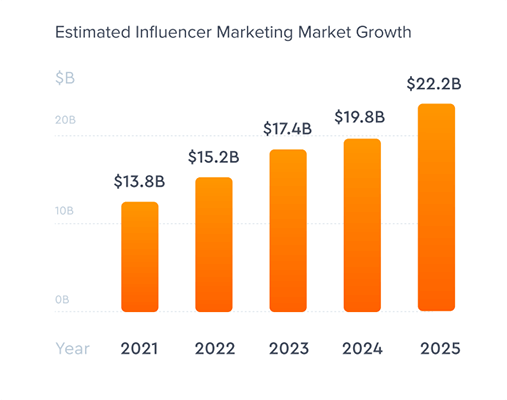
One of the reasons for the growth is the reallocation of marketing budgets from television. print, and other offline media toward digital advertising. The wide adoption of ad-blocking software is also pushing advertisers to consider using influencers to push their products and services.
This is a good sign for anyone invested in influencer marketing. The industry is headed in the right direction for the next couple of years.
Source: HypeAuditor
2. 41% of users like taking advantage of discounts from influencers
The Social Commerce 2022 Report stated that 41% of users strongly agree that they like taking advantage of discounts being offered by influencers.
That’s great news for businesses that like promoting their products through special offers. You can just let influencers share those discount codes and their followers will become more inclined to use them.
The same report says that 57% have purchased a product during a livestream event. 39% added that they like to discover new products while watching a livestream. So if you haven’t looked into influencers that love to stream, maybe you should.
82% discovered a product while on social media and bought directly using their phones.
Source: Social Commerce 2022 Report via Global Newswire
3. Consumers find influencers more trustworthy
When Covid-19 restrictions forced people to spend more time in their homes, they turned to social platforms and spent more time with influencers than they did before.
And it could be for that very reason that people are now finding influencers more trustworthy than before. 61% said that they’d trust recommendations from influencers as they would from family and friends. Meanwhile, only 38% said they’d trust recommendations from a brand on social platforms.
Of those surveyed, the most trusting would be those aged 18-29 at 66%. It’s then followed by those aged 30-44 (61%) and 45-60 (60%). Only 53% of those aged over 60 will take recommendations from influencers.
This makes sense. Celebrity endorsements always felt fake — or at least that’s what other people argue. But when an endorsement comes from an influencer, it feels way more organic. It’s like getting a recommendation from an expert that also happens to be a friend.
Source: Matter Communications via BusinessWire
4. 70% of teenage YouTube subscribers trust creators over celebrities
According to Google, 70% of teenage YouTube subscribers are more likely to trust YouTube creators than they would celebrities. It goes on to say that 4 in 10 of its millennial subscribers feel that their favorite creators understand them better than their own friends.
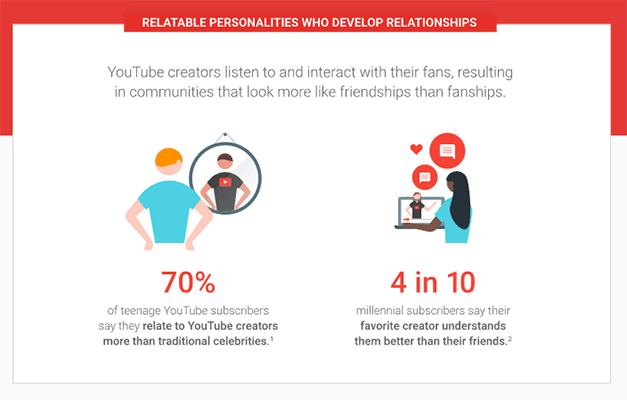
And because YouTube creators are able to develop stronger ties with their fans, their audience becomes more engaged with every video. Compared to celebrities, a creator can get 3 times more views and 12 times more comments.
In addition, millennials view YouTube influencers as trendsetters. 7 in 10 users believe that creators are changing and shaping the culture.
Source: Think With Google
5. 53% of women bought products because of influencers
An AdWeek survey found that 53% of women have made purchases because of posts that influencers have made.
Women are one of the most active groups on social media. Not only that, they are one of the most discerning groups as well. They’re also willing to buy products based on influencer recommendations.
Source: Adweek
6. 22% of brands struggle to find influencers
Companies are finding it more and more difficult to find influencers to work with. 22% described the task as being difficult. On a somewhat positive note, the same percentage of people found it easy to find influencers.
56% said that they only found it of “medium difficulty”.
As a marketer, you don’t want to just work with an influencer because of their audience size and engagement numbers — though these are important factors as well. What you want, first and foremost, are influencers that fit your branding.
That’s the reason why some marketers are willing to work with influencer agencies. They can help streamline the process and introduce you to influencers that are aligned with your brand.
Source: Ecommerce Bonsai
7. 81% of users research products on Instagram
81% of Instagram users said that they go on the platform to research products and services they are interested in. 80% added that they use Instagram to decide if they should make a purchase.
This goes to show the role that influencers on the platform play when it comes to purchasing decisions. It’s also a sign that businesses should continue to have a presence on the platform.
Source: Blogging Wizard
Influencer marketing and advertising: statistics and facts
It’s amazing how big of an impact an influencer marketing campaign has on digital marketing. Most companies believe that influencer marketing has surpassed traditional advertising. And as such, they’re making moves like adjusting their influencer marketing budgets.
But there have been recent developments that have caught experts off guard. For instance, did you know that nano- and micro-influencers get better engagement rates than mega-influencers?
Here are some statistics on how influencer marketing is changing advertising on social media.
8. Influencers will be prominent in Super Bowl 2022
The Super Bowl has always been a draw for people in the US whether they’re football fans or not. And this year’s event is no different. Some viewers even watch the show specifically for the commercials.
According to GRIN VP of Marketing Ali Fazal, people are eager to see which influencers will be making an appearance and which brands they’re representing. Gen Z, in particular, will be paying close attention.
Influencers appeal to Gen Z users because they value authenticity. They want to buy from brands that they’re able to trust. And if they see influencers they know and trust working with a company, they’ll have a good reason to give it a try.
Source: Forbes
9. Agencies need to change influencer marketing ROI metrics
Rahul Titus, Ogilvy’s head of influence, says that it’s time for influencers and marketers to shift from engagement metrics to outcome-based metrics when it comes to measuring the success of their campaigns.
As Rahul explains, clients are now spending millions on influencer marketing. And when stakes are that high, accountability comes into play. As he puts it: “As an industry, we’ve been quite lazy if I’m being very honest. We haven’t measured [the] outcome because we’ve never been asked before now.”
This shift in metrics might come sooner than later as it’s expected to happen in the next 12 months.
Source: The Drum
10. Nano- and micro-influencers get more engagement than mega-influencers
Influencer Marketing Hub, the guys behind The State of Influencer Marketing 2020 report, analyzed more than 100,000 influencer profiles across Instagram, TikTok, and Twitter to see what kind of engagement rates influencers were getting.
As it turns out, nano-influencers (or those with fewer than 1,000 followers) get 7 times the engagement rate than mega-influencers (100,000+ followers) on Instagram.
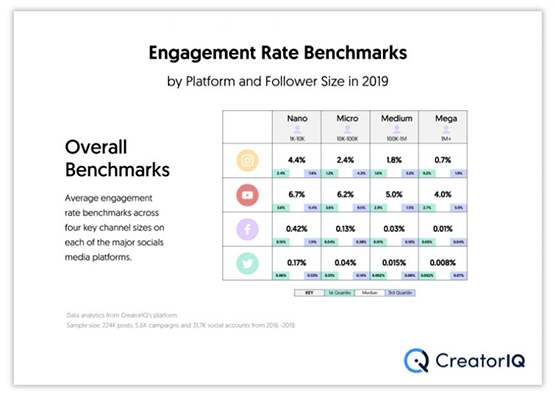
It’s almost the same story on other social media platforms. So if you want to invest in influencers, look for nano- and micro-influencers first.
CreatorIQ also launched a similar study. And while there were some differences because of the engagement bands used, the conclusion is quite similar.
Source: The State of Influencer Marketing 2020
11. Influencer marketing gets you better customers
More than half of surveyed marketers (51%) said that influencer marketing helped them acquire better customers.
And by better customers, they just don’t mean customers that buy a product once. What they’re referring to are customers that make recurring purchases and become loyal to the brand.
While it’s normally challenging to convert a customer into brand advocates, influencer campaigns can make all the difference. If you use influencer marketing and make the commitment to improve your customer experience and retention, you’ll make the most out of the leads that influencers throw your way.
Source: Smart Insights
12. 74% of users spends up to $629 on influencer-recommended products
Most people will spend up to $629 on products recommended by their favorite influencers. That’s about 3 in 4 users.
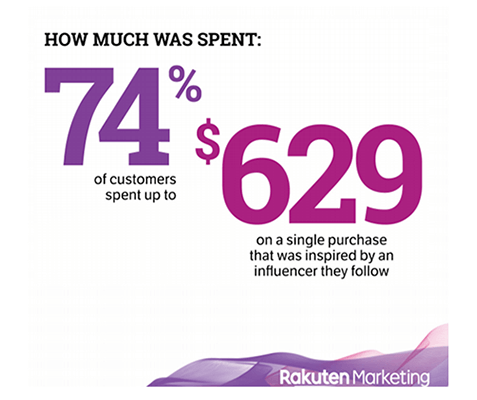
42% of those users won’t spend as much but they will still pay $100 or less if they find a recommendation useful for them.
Source: Ecommerce Bonsai
Influencer marketing and social media platforms: statistics and facts
Influencer marketing and social media platforms are making waves in the digital advertising space. Marketers are having success using social media to find their target audience and engage them through the platform’s influencers.
Social media sites are also taking notice. Take TikTok as an example. It launched a program that supports influencers on the platform and helps them connect with brands looking for partners.
These are facts and statistics about the role that social media plays in influencer marketing.
13. 68% of marketers use Instagram for influencer marketing
Instagram currently has 2 billion active monthly users. This is perhaps the reason why 68% of marketers use this platform for their influencer marketing campaigns.
The platform has become very popular with advertisers because it manages to remove the barriers of traditional advertising in the sense that customers are hearing about a brand from someone that they trust. This adds to a brand’s credibility.
Source: HypeAuditor
14. TikTok launched the $200 million creator fund for influencers
TikTok is currently throwing a lot of support for its creators. That’s why it launched its TikTok Creator Fund, a program that encourages its users to start a career through the platform. The $200 million fund will be distributed over a year — and that amount is still expected to grow in time.
The TikTok Creator Marketplace is part of that initiative. It’s a place where brands can connect with innovative creators so that they can collaborate on paid campaigns. Through the marketplace, brands will be able to drive awareness and attract new customers.
Source: TikTok Newsroom
15. Instagram is still the best platform for influencer campaigns
In 2020, 90% of all influencer campaigns targeted Instagram. It’s possibly the most frequently used distribution platform for influencer campaigns.
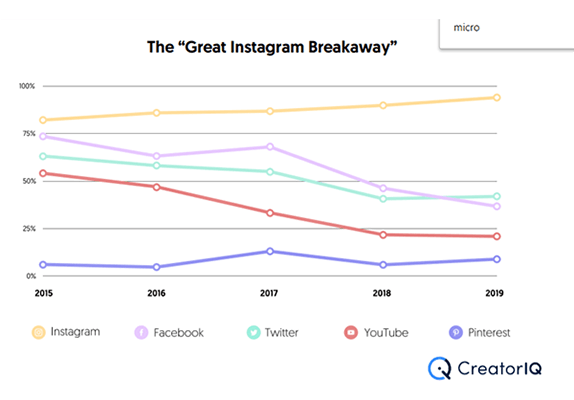
Because Instagram is all about visuals, this platform has become ideal for advertising. Also, creators and users on Instagram are able to connect on a deeper level compared to other social sites.
Source: Ecommerce Bonsai
16. Instagram influencer marketing grew by 48% in 2019
2019 was a big year for influencer marketing on Instagram. That’s when it grew by 48% on the platform.
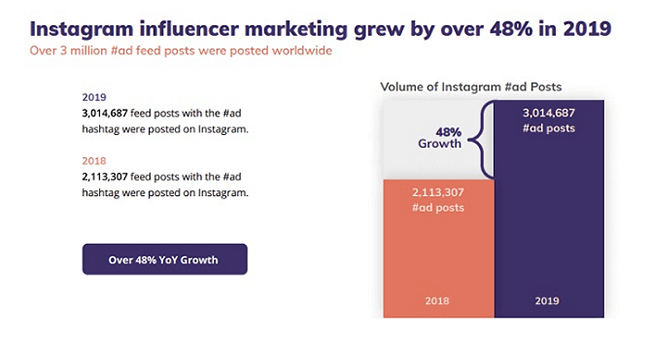
Marketers simply love how visual the platform is — making it the ideal place to promote products and services, especially through IG Feeds and Stories.
Source: Blogging Wizard
Influencer marketing and business: statistics and facts
Influencer marketing is big business. Not just for brands and influencers but agencies as well. Did you know that a teenager in Canada managed to launch an influencer agency while schools were on lockdown?
And there are more people launching influencer agencies. 380 were started in 2019 alone. And judging by how successful influencer marketing is for businesses, there may be more coming soon.
Here are some facts and statistics relating to influencer marketing and businesses.
17. An influencer management agency booked $1+ million in revenue
The 28-year-old founder of EYC, Cora Delaney, managed to book more than $1 million in revenue in 2021. EYC is a London-based talent management agency that focuses on influencers.
What’s even more impressive is that she’s on track to double that revenue in 2022.
EYC’s clients currently include the likes of Apple, Prada, Warner Music Group, Gucci, and Louis Vuitton.
Source: Business Insider
18. A teenager launched a successful influencer marketing business
A Canadian teenager named Christian Di Bratto managed to launch a successful influencer marketing business during the Covid-19 lockdown. While his school was closed, he started Koala Digital — a brokering agency that secured partnership deals between TikTok creators and brands.
At 19 years old, he managed to broker deals between big brands and talents worth $140,000 in just under 16 months.
His long-term plans include running campaigns as an influencer marketing agency instead of being strictly a talent agent.
Source: Forbes
19. There’s a 35% wage gap between black and white influencers
Unfortunately, a study revealed that there’s a 35% wage gap between black and white influencers.
Gild Creative Group CEO Tiffany Hardin explained that when people of color negotiate with brands, they often feel like they don’t have a choice but to accept whatever’s offered to them. They fear that saying no would close the door for future projects.
It also doesn’t help that there’s no industry regulation. Using an agency might help since it can bridge the gap and even the playing field.
Source: Adweek
20. 380 influencer marketing agencies and platforms were created in 2019
In 2019, 380 influencer marketing agencies and platforms were added to the list of existing ones. That placed the total to roughly 1,120.
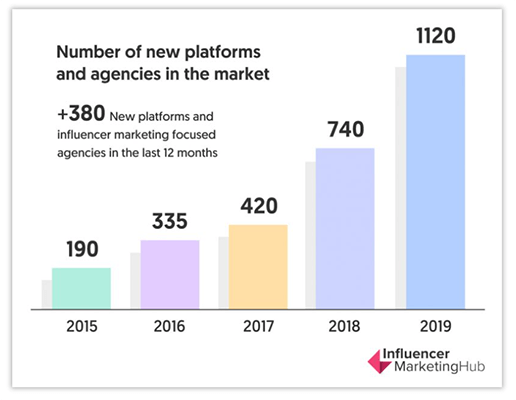
For reference, there were only around 190 influencer platforms and agencies in 2015. So the influencer marketing industry is growing at a rapid pace.
As the industry grows, more companies and apps are working to simplify the process of connecting brands and creators.
Source: The State of Influencer Marketing 2020
Conclusion
There are plenty of reasons to become invested in influencer marketing. It’s a great way to get your brand out there. It’s also an effective way of gaining credibility since people are more trusting of influencers than they are of brands.
And the ROI can be far better than traditional advertising methods.
This is why a lot of brands are moving budgets away from traditional advertising and investing in influencer marketing instead. It’s a fantastic lead generation strategy.
With that said, you should continue to have an active role on social media. It’s important to post regular updates so when influencers introduce you to your audience, they can hop on your account and see what your brand is all about.
If you’re having trouble publishing content regularly, you should look into using social media schedulers.

